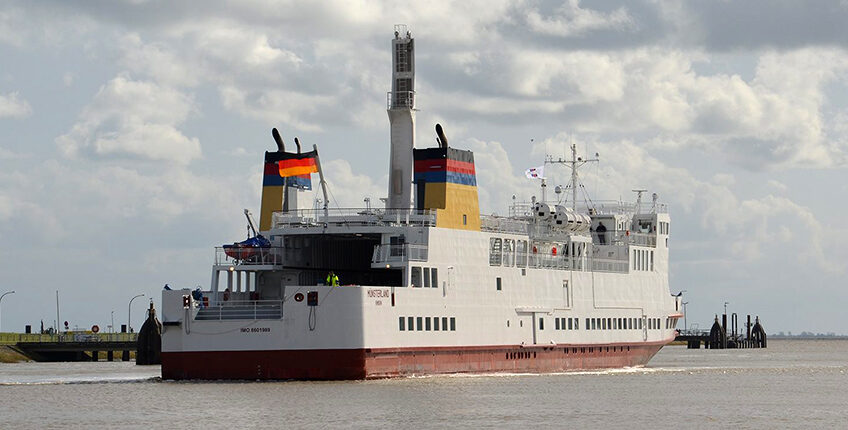After 16 months of construction, the MS Münsterland ferry of AG EMS is back in regular service on the route between Borkum and the Dutch port of Eemshaven. The Münsterland is the third LNG vessel in the AG EMS Group. It was converted from regular diesel propulsion to the more environmentally friendly alternative, liquefied natural gas (LNG). To achieve this, AG EMS received funding support from the Federal Ministry of Digital and Transport's (BMDV) guideline on funding for equipping and retrofitting seagoing vessels for the use of LNG as a maritime fuel.
LNG stands for Liquefied Natural Gas, a gas that consists mainly of methane and is cooled down to minus 162 °C. LNG allows for a reduction of nitrogen oxides and sulphur oxides of up to 95 percent as well as cutting carbon dioxide by 20 percent and almost completely eliminating particulate matter. In December 2020, the MS Münsterland left for her lay-up at the shipyard of Koninklijke Niestern Sander BV in Farmsum near Delfzijl in the Netherlands. On 9 April 2022, the ferry returned to Borkum to take up regular service after a construction period that took around 16 months.
Climate-friendly ferry service in the North Sea tidal flats
With its sister ship the MS Ostfriesland, AG EMS put the EU’s very first converted LNG ferry into service in 2015. The MS Ostfriesland serves the Emden-Borkum route, while the new-built vessel, the MS Helgoland, is in operation with LNG on the Helgoland route. With the MS Münsterland, the shipping company continues to focus on sustainability and environmentally friendly ship design. “We have been dubbed a first mover throughout the EU, and that is what we want to remain. This includes not only being the first to use LNG, but also consistently developing and pursuing this,” says AG EMS Board Member Dr Bernhard Brons.
Conversion creates space for technology and gas tanks
The centrepiece of the converted MS Münsterland is to be found in the ship’s new stern. Here, the new technology with gas tank and two Type 6 L 20 DF Wärtsilä engines and an auxiliary generator from Scania are installed. A maximum speed of 16 knots can be achieved. The Type C liquefied gas tank is the same as that already in use on the MS Ostfriesland. The tanks consist of an inner tank and an additional outer tank for protection. A vacuum insulation between them ensures that the ambient conditions remain constant, as the liquefied gas is stored in the tank at -162° C and at a pressure of 5 bar.
A new aspect is the size of the special tank installed. Unlike the MS Ostfriesland, which has a geometric volume of 45 m³, the tank of the MS Münsterland holds 53 m³. The larger volume was attained through the enlargement of the inner diameter of the tank and improved insulation, resulting in a reduced thickness of the layers. The GVU (gas valve units) could now be accommodated in the tank installation room, freeing up this space in the engine room. Further space for the innovative technology was created by extending the ship by 15 m to now 94 m. There is room for 1,248 passengers on board, as well as 75 passenger cars or a corresponding amount of cargo.
BMDV funding for the conversion
The MS Münsterland resumed scheduled services from Borkum to Eemshaven on 9 April 2022. Minor remaining work will be carried out in the days that follow. The investment sum for the conversion amounted to around 19 million euros and was funded by the Federal Ministry of Digital and Transport (BMDV – Bundesministerium für Digitales und Verkehr) within the framework of the guideline on funding for equipping and retrofitting seagoing vessels for the use of LNG as a maritime fuel. NOW provided coordinating support for the project.
Further information on the MS Münsterland conversion project: www.now-gmbh.de/projektfinder/lng-umruestung-der-roro-faehre-ms-muensterland
Image source: AG EMS


